
2010 Mazda 3
When setting out to build a race car, there's always a plan of attack. Different types of racing not only cater to certain types of cars but have varying rules to which all cars that wish to compete must adhere. The guys over at Tri-Point Engineering know this all too well, considering the way things have panned out with their most recent project. When Mazda approached Tri-Point to build a few '10 Mazda3 sedans for competition in the '10 SCCA Racing World Challenge Touring Car series, the guys got to work right away. What they came up with is a truly great race car, but sadly this car will never see track time in the race series it was originally designed for. A very late-in-the-game change to the rule book of the World Challenge series has rendered Tri-Point's 3 ineligible in it's current state.
But all hope is not lost. With so many types of racing out there, there's bound to be a home for this lonely sedan. "We built the car based on the rule book that was given to us," Mark Shuler of Tri-Point Engineering says, "and then in the off-season, they pulled a complete 180 on us." An understandably frustrating scenario for anyone, after all with so much time and effort put into the car, it would be a shame to put it out of commission forever because of a few technicalities. Tri-Point is currently reevaluating its options and plans to get the car ready for some sort of racing in 2010-somewhere the 3 can fit in.
"We took delivery on the Mazda3 in March 2009," says Chris Nagler of Tri-Point. "We also received a couple Mazda3 'bodies in white' [a completely bare shell from the manufacturer to be used for race purposes only] around the same time. The sedan was chosen over the five-door body style for aerodynamic reasons." The purpose of this car is not to look pretty, but to go fast, so the exterior package is simple. Consisting of a custom one-off Tri-Point Engineering carbon-fiber front splitter, rear spoiler and a Mazda racing graphics package, the sedan looks as serious as it runs.
The motor build was handled by Comptech USA, a familiar name in the world of tuning and racing. Although the company now sells parts for Honda and Acura cars under the new name of CT Engineering, Comptech USA still offers engine building and machine services. With a target goal of 270 hp for the World Challenge race series in mind, Comptech assembled the motor using high-compression JE pistons, its own flavor of customized performance camshafts and modified connecting rods for added strength and durability. The idea here is to have a strong motor that makes good reliable power and doesn't need to be rebuilt after every race. A Motec M400 EMS was dialed in on the dyno for a perfect race tune.
2010 Mazda 3 Pipe
Tri-Point knew the best way to get this power to the ground was an Xtrac sequential 6-speed transmission. These transmissions are used on many race cars because not only are they extremely durable but specially designed for heavy-duty race use. Many hours of research and development, precise micro engineering and Xtrac's use of special in-house metallurgy techniques ensure that as much power as possible is transferred from the flywheel to the sedan's front wheels.
To get all the noxious exhaust gases out of the engine quickly and efficiently, Tri-Point fabricated a one-off custom exhaust system comprised of a 4-2-1 tubular exhaust manifold that expels gases through a short after-header piece that cuts off right before the rear suspension. Maximum flow and the perfect amount of exhaust gas pressure is achieved due to a straight-through, mandrel-bent design that uses no catalytic converter or muffler, just a small resonator after the B-pipe.
Like any competitive race car, the Tri-Point sedan has undergone serious suspension work. In fact, because it started life as a stock showroom car, the entire suspension has been engineered from the ground up to suit Tri-Point's needs. A custom rollcage was designed and fitted into the car as collaboration between Mazda USA and Tri-Point Engineering. One interesting feature of the cage design is that Tri-Point was able to omit the heavy cage door bars typically needed for side impact by building a custom Kevlar driver impact brace. This little box is extremely lightweight, very strong and acts as a crumple zone in case of an accident, protecting the driver from any side impact.
The car has also been set up with modified suspension pickup points for extremely accurate fine-tuning of the car's handling. Unfortunately, many types of racing don't allow modified suspension pick-up points, so this is one area where Tri-Point will have to spend some time reverse-engineering the 3 to adhere to the rules for whatever series it ultimately decides to run the car in. A set of beefy one-off rear control arms were fabricated along with a set of tubular sway bars, measuring 31mm up front and a massive 45mm in the rear. All this combined with customized Koni dampers and Hypercoil race springs proves that there's no doubt this sedan can handle its way around any road course you throw at it.
Stopping power is put in place thanks to StopTech Trophy Race calipers and large drilled AeroRotors. This setup is a major upgrade from factory Mazda brakes, as you would expect, and hardly a single piece of this car has been left untouched. Wheels and tires are race bred as well, 17x8-inch Racing Hart forged race wheels paired with sticky Toyo R888 tires.
What Tri-Point has here is an extremely well-built race car, with no place to race. Yet, the original plan was to manufacture parts for customers based on the car you see here and also build up the 3 other race shells they received at the same time. None of those cars are completed as of now because of the proverbial "wrench" thrown into the plans by the rule change to the World Challenge race series for 2010, but we have faith in the ingenuity and creativity of Mark and Chris and the Tri-Point staff. Don't be surprised to see this car putting in work somewhere soon.
Worth Knowing Tri-Point Engineering was founded in 1979 when the Mazda RX-7 first became available. Starting out with high-performance work on rotary-powered cars, Tri-Point and Mazda now work together closely on many projects including bolt-on turbo kits for many applications. Tri-Point has competed in all sorts of racing since its 1990 debut with a '87 RX-7 SCCA Solo II race car.
Specs & Details
'10 Mazda3
Engine 2.5-liter, 4-cylinder built by Comptech USA
Engine Modifications JE 12.5:1 forged pistons, modified factory connecting rods, Comptech performance camshafts, Ron Davis Racing Radiator w/ heat exchanger
Engine Management Motec M400 w/ throttle-by-wire & cam control, tuned for Sunoco GTX260 Octane race fuel
Drivetrain Xtrac 6-speed sequential gearbox, clutch-type limited-slip differential
Suspension Tri-Point Engineering tubular adjustable sway bars 31mm (f) & 45mm (r) Mono Ball suspension pickup points, billet front control arms, custom fabricated rear lower control arms; Koni 2817/2812 (2-way adjustable) Dampers Built by ProParts USA, Hypercoil Race Springs
Interior Tri-Point Engineering/Solidworks rollcage, Sparco ProAdv bucket seat, quick-release steering wheel hub, 325 steering wheel; Safecraft 6-point harness, 10# Fire System; custom Kevlar driver door crash protector, Motec ADL3 data logger
Numbers 270 hp at 7800 rpm (World ChallengeTarget HP), 220 ft-lbs of torque at 6400 rpm
Thanks To Mazda North American Operations, Mazdaspeed Motortsports Development, Comptech USA, StopTech, Rod Davis Racing, Motec, ProParts USA, Sparco, Safecraft
Worth Knowing
The SCCA Racing World Challenge series has gone through many evolutions since its inception in the year 1972. What started off as a series to race completely stock automobiles with a cap of a measly $3,000 has morphed into a massive worldwide race sanctioning body, with many different classes and rule books.
Source: http://www.modified.com/
Source: http://www.modified.com/




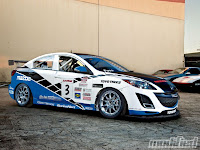
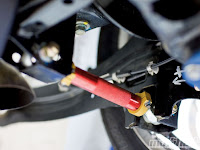

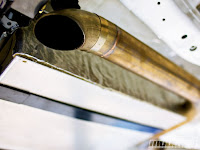

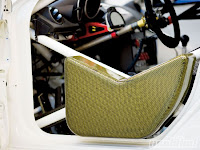





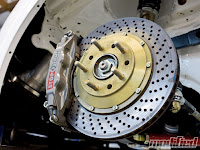















0 comments:
Post a Comment